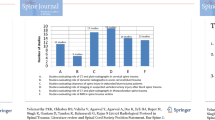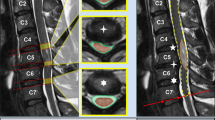Abstract
Background and purpose
Spinal cord compression (SCC) requires rapid diagnosis in the emergent setting; however, current MRI protocols may be cumbersome for patients and clinicians. We sought to validate an abbreviated total spine MRI (TS-MRI) protocol using standard non-contrast sequences in the detection of SCC and other clinically significant findings (OCSF).
Methods
Two hundred six TS-MRI scans obtained over a 30-month period for SCC were included. Sagittal T2 (T2sag), sagittal T1 (T1sag), and sagittal STIR (IRsag), as well as axial T2 (T2ax) images, were individually assessed independently by 2 reviewers for SCC, cauda equina compression (CEC), and OCSF. A protocol consisting of all the sequences was considered the gold standard. Sensitivity and specificity of single and combined MRI sequences for SCC/CEC and OCSF were determined and were tested for noninferiority relative to standard non-contrast sequences using a 5% noninferiority margin.
Results
An abbreviated protocol of IRsag + T2ax provided the best performance with sensitivity and specificity of 100% (95%CI, 96.0–100.0) and 98.6% (95%CI, 95.6–99.7) for SCC/CEC and 100.0% (95%CI, 96.7–100.0), and 99.3% (95%CI, 96.6–99.9) for OCSF. The mean difference of sensitivity and specificity between IRsag + T2ax and standard protocol was 0.0% (95%CI, 0.0–4.0) and − 2.1% (95%CI, − 5.4 to − 0.6) for SCC/CEC and 0.0% (95%CI, 0.0–3.3) and − 1.5% (95%CI, − 4.8 to − 0.3) for OCSF, all within the noninferiority margin of 5%.
Conclusions
An abbreviated TS-MRI protocol of IRsag + T2ax is noninferior to the standard non-contrast protocol, potentially allowing for faster emergent imaging diagnosis and triage.



Similar content being viewed by others
Data availability
Research data is confidential, and it is not available publicly. De-identified data will be provided if requested.
Code availability
Codes will be provided if requested.
Abbreviations
- ED:
-
Emergency department
- IRsag :
-
Sagittal STIR
- OCSF:
-
Other clinically significant findings
- SCC/CEC:
-
Spinal cord compression and/or cauda equina compression
- T1sag :
-
Sagittal T1 weighted
- T2sag :
-
Sagittal T2 weighted
- T2ax :
-
Axial T2 weighted
- TS-MRI:
-
Total spine MRI
References
Black DF, Wood CP, Wells ML, Erickson BJ, Diehn FE, Kaufmann TJ et al (2015) Emergent, after hours magnetic resonance imaging of the spine. J Neuroimaging 25(4):590–594
Rosenkrantz AB, Hanna TN, Babb JS, Duszak R Jr (2017) Changes in emergency department imaging: perspectives from national patient surveys over two decades. J Am Coll Radiol 14(10):1282–1290
Ahad A, Elsayed M, Tohid H (2015) The accuracy of clinical symptoms in detecting cauda equina syndrome in patients undergoing acute MRI of the spine. Neuroradiol J 28(4):438–442
Rooney A, Statham PF, Stone J (2009) Cauda equina syndrome with normal MR imaging. J Neurol 256(5):721–725
Ropper AE, Ropper AH (2017) Acute spinal cord compression. N Engl J Med 376(14):1358–1369
Davis JW, Phreaner DL, Hoyt DB, Mackersie RC (1993) The etiology of missed cervical spine injuries. J Trauma 34(3):342–346
Gitelman A, Hishmeh S, Morelli BN, Joseph SA Jr, Casden A, Kuflik P et al (2008) Cauda equina syndrome: a comprehensive review. Am J Orthop (Belle Mead NJ) 37(11):556–562
Gardner A, Gardner E, Morley T (2011) Cauda equina syndrome: a review of the current clinical and medico-legal position. Eur Spine J 20(5):690–697
Huang CWC, Ali A, Chang YM, Bezuidenhout AF, Hackney DB, Edlow JA et al (2020) Major radiologic and clinical outcomes of total spine MRI performed in the emergency department at a major academic medical center. AJNR Am J Neuroradiol 41(6):1120–1125
Degnan AJ, Ghobadi EH, Hardy P, Krupinski E, Scali EP, Stratchko L et al (2019) Perceptual and interpretive error in diagnostic radiology-causes and potential solutions. Acad Radiol 26(6):833–845
Shah NA, Hoch M, Willis A, Betts B, Patel HK, Hershey BL (2010) Correlation among on-call resident study volume, discrepancy rate, and turnaround time. Acad Radiol 17(9):1190–1194
Kim JK, Learch TJ, Colletti PM, Lee JW, Tran SD, Terk MR (2000) Diagnosis of vertebral metastasis, epidural metastasis, and malignant spinal cord compression: are T(1)-weighted sagittal images sufficient? Magn Reson Imaging 18(7):819–824
Wang B, Fintelmann FJ, Kamath RS, Kattapuram SV, Rosenthal DI (2016) Limited magnetic resonance imaging of the lumbar spine has high sensitivity for detection of acute fractures, infection, and malignancy. Skeletal Radiol 45(12):1687–1693
Bilsky MH, Laufer I, Fourney DR, Groff M, Schmidt MH, Varga PP et al (2010) Reliability analysis of the epidural spinal cord compression scale. J Neurosurg Spine 13(3):324–328
Weber C, Rao V, Gulati S, Kvistad KA, Nygaard OP, Lonne G (2015) Inter- and intraobserver agreement of morphological grading for central lumbar spinal stenosis on magnetic resonance imaging. Global Spine J 5(5):406–410
Landis JR, Koch GG (1977) The measurement of observer agreement for categorical data. Biometrics 33(1):159–174
Ahn S, Park SH, Lee KH (2013) How to demonstrate similarity by using noninferiority and equivalence statistical testing in radiology research. Radiology 267(2):328–338
Mirowitz SA, Apicella P, Reinus WR, Hammerman AM (1994) MR imaging of bone marrow lesions: relative conspicuousness on T1-weighted, fat-suppressed T2-weighted, and STIR images. AJR Am J Roentgenol 162(1):215–221
Richards PJ (2005) Cervical spine clearance: a review. Injury. 36(2):248–69 (discussion 70)
Bley TA, Wieben O, Francois CJ, Brittain JH, Reeder SB (2010) Fat and water magnetic resonance imaging. J Magn Reson Imaging 31(1):4–18
Stabler A, Reiser MF (2001) Imaging of spinal infection. Radiol Clin North Am 39(1):115–135
Bertino RE, Porter BA, Stimac GK, Tepper SJ (1988) Imaging spinal osteomyelitis and epidural abscess with short TI inversion recovery (STIR). AJNR Am J Neuroradiol 9(3):563–564
Silvestre JF, Banuls J, Ramon R, Guijarro J, Botella R, Betlloch I (2000) Unilateral multiple facial angiofibromas: a mosaic form of tuberous sclerosis. J Am Acad Dermatol 43(1 Pt 1):127–129
Mascalchi M, Dal Pozzo G, Bartolozzi C (1993) Effectiveness of the short TI inversion recovery (STIR) sequence in MR imaging of intramedullary spinal lesions. Magn Reson Imaging 11(1):17–25
Hittmair K, Mallek R, Prayer D, Schindler EG, Kollegger H (1996) Spinal cord lesions in patients with multiple sclerosis: comparison of MR pulse sequences. AJNR Am J Neuroradiol 17(8):1555–1565
Koontz NA, Wiggins RH, 3rd, Mills MK, McLaughlin MS, Pigman EC, Anzai Y, et al (2017) Less is more: efficacy of rapid 3D-T2 SPACE in ED patients with acute atypical low back pain. Acad Radiol 24(8):988–94
Robertson WD, Jarvik JG, Tsuruda JS, Koepsell TD, Maravilla KR (1996) The comparison of a rapid screening MR protocol with a conventional MR protocol for lumbar spondylosis. AJR Am J Roentgenol 166(4):909–916
Sayah A, Jay AK, Toaff JS, Makariou EV, Berkowitz F (2016) Effectiveness of a rapid lumbar spine MRI protocol using 3D T2-weighted SPACE imaging versus a standard protocol for evaluation of degenerative changes of the lumbar spine. AJR Am J Roentgenol 207(3):614–620
Lee S, Jee WH, Jung JY, Lee SY, Ryu KS, Ha KY (2015) MRI of the lumbar spine: comparison of 3D isotropic turbo spin-echo SPACE sequence versus conventional 2D sequences at 3.0 T. Acta Radiol. 56(2):174–81
Gewirtz JI, Skidmore A, Smyth MD, Limbrick DD, Goyal M, Shimony JS et al (2020) Use of fast-sequence spine MRI in pediatric patients. J Neurosurg Pediatr 26(6):676–681
Sugahara T, Korogi Y, Hirai T, Hamatake S, Ikushima I, Shigematu Y et al (1997) Comparison of HASTE and segmented-HASTE sequences with a T2-weighted fast spin-echo sequence in the screening evaluation of the brain. AJR Am J Roentgenol 169(5):1401–1410
Author information
Authors and Affiliations
Contributions
Rafeeque A. Bhadelia and Yu-Ming Chang contributed to the study conception and design. Material preparation, data collection, and analysis were performed by Yu-Ming Chang, Harry Griffin, Seyed Amir Ebrahimzadeh, and Rafeeque A. Bhadelia. The first draft of the manuscript was written by Yu-Ming Chang with comments by all authors. All authors commented on all versions of the manuscript. All authors read and approved the final manuscript.
Corresponding author
Ethics declarations
Ethics approval
Institutional review board approval for this retrospective study with a waiver of informed consent was obtained.
Consent for publication
All authors have read and approved the final manuscript.
Conflicts of interest
The authors declare that they have no conflict of interest.
Additional information
Publisher’s note
Springer Nature remains neutral with regard to jurisdictional claims in published maps and institutional affiliations.
Rights and permissions
About this article
Cite this article
Chang, YM., Ebrahimzadeh, S.A., Griffin, H. et al. Shortened total spine MRI protocol in the detection of spinal cord compression and pathology for emergent settings: a noninferiority study. Emerg Radiol 29, 329–337 (2022). https://doi.org/10.1007/s10140-021-01956-9
Received:
Accepted:
Published:
Issue Date:
DOI: https://doi.org/10.1007/s10140-021-01956-9




